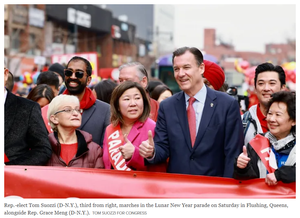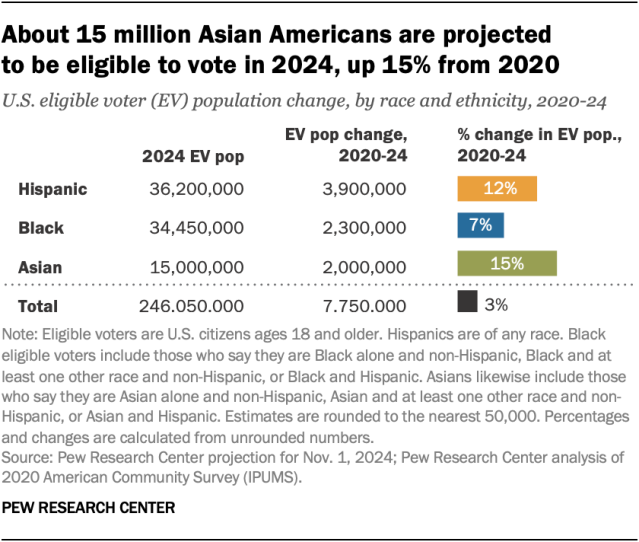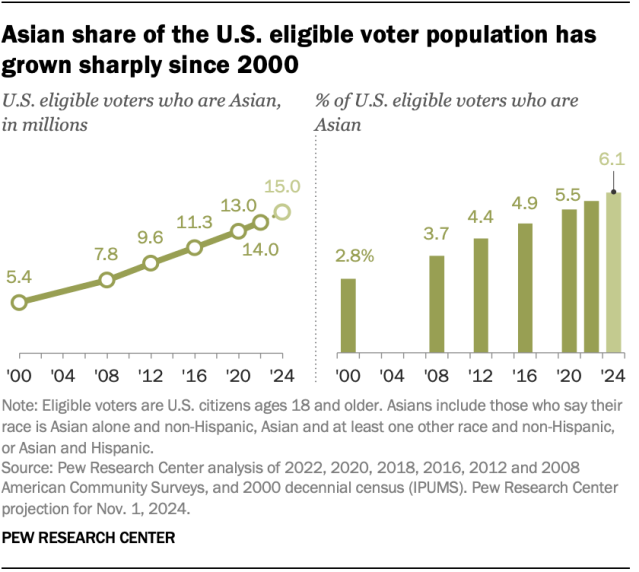New York's Special Election Reveals Roadmap To Tapping The Fast Growing Influence Of Asian Americans In US Elections

When Democratic-elect Congressman Tom Suozzi stopped by a Queens, New York Chinese restaurant in February to celebrate the Lunar New Year and eat dimsum and siopao with patrons, it wasn’t just a chance visit meant to court the area’s many Chinese constituents. It was one small part in the Suozzi campaign’s multi-pronged approach to lure Asian Americans in New York’s Congressional 3rd district in the special election held to replace the disgraced Republican George Santos, who had recently been expelled from congress.
Suozzi went on to win the election against Republican opponent Mazi Pilip with an 8 point margin of victory. That represented a whopping 16 point turn around for Democrats from the 2022 election that saw Santos claim the seat.
Mainstream pundits chalked up Suozzi’s impressive victory to the fact that he ran as a moderate in a swing district, and focused on bread and butter issues like the economy, securing the border, and lowering taxes.
However, what many analysts missed out on was the fact that Suozzi and his allies poured enormous effort and resources into reaching out to the large Asian American population in the 3rd district. And they did it in a way that bodes well for Democrats nationally if they follow the same template. According to the latest US Census, one in four residents of New York’s 3rd District is Asian American. It’s a diverse group made up of Chinese Americans, Korean Americans, Indian Americans, Filipino Americans, Pakistani Americans, and Bangladeshi Americans.
Suozzi’s campaign abandoned making broad appeals to the Asian American population in general, a practice quite common in the past among both major political parties. Instead they designed an approach that would target each sub-group individually.

One example of how detailed the campaign got in terms of the local Asian American community was their partnership with Asian American and Pacific Islanders Victory Fund (AAPIVF), a national political action committee that promotes and supports Asian American, Native Hawaiian, and Pacific Islander (AANHPI) candidates and those that reflect their concerns for elected office at all levels of government.
The AAPIVF targeted around 40,000 South Asian registered voters in the 3rd district with tailored messages in four languages (English, Hindi, Urdu, and Arabic) sent out through mail, texting, live calls, robocalls, and in-language ads in prominent local cultural news outlets. Suozzi’s own campaign targeted Chinese voters in the same manner.
The strategy clearly paid off. Suozzi took the Queens section of the 3rd District, where the majority of the Asian American community resides, by more than 20 percentage points. In 2022, Democrat Robert Zimmerman won this part of the district by just four points.
“The Democrats finally woke up and figured it out,” said Larry Levy, executive dean of the National Center for Suburban Studies at Hofstra University in an article published in the Huff Post. “They couldn’t ignore Asians and just assume that every time [former President Donald] Trump dissed Asians, they would show up for Democrats.”
Not only did Suozzi’s victory provide a much needed boost to Democrats’ hopes of retaking the House in November, it provided a detailed roadmap on how to reach and activate the growing and increasingly influential Asian American electorate and actually win elections, especially in battleground states. That means campaigns have to forgo broad messages to “Asian Americans” in favor of going down to the granular level with campaign materials and other communications in native languages.
“Investment in communicating to Asian American voters is how Democrats win all across the country,” said Shekar Narasimhan, chairman and founder of the AAPI Victory Fund.
The growing power of Asian Americans is clearly an electoral phenomenon that both parties need to pay extra special attention to. According to a recent survey by the Pew Research Center, over the past 20 years Asian Americans make up the fastest growing group of eligible voters in the United States. In fact their numbers have grown by an incredible 15% since 2020, or about 2 million eligible voters.

As of 2022, most Asian American eligible voters (55%) live in only five states. California has the highest number of Asian American eligible voters by far (4.4 million total, 1,651,933 Filipinos). The state is home to nearly a third (31%) of the entire U.S. Asian electorate. The states with the next-most Asian American eligible voters are New York (1.2 million), Texas (1.1 million), Hawaii (580,000) and New Jersey (575,000). But there are many Asian Americans now living in important swing states. Many analysts have chalked up President Biden’s 2020 win in Georgia to the large Asian American community living in the Atlanta area.
That’s not surprising because Asian Americans typically lean Democratic. According to a Pew Research Center analysis of validated voters in 2020, 72% of English-speaking, single-race, non-Hispanic Asian voters said they voted for Democrat Joe Biden for president, while 28% said they voted for Republican Donald Trump.
And Asian Americans have a wide range of concerns regarding important issues, including health care, the economy, gun control, climate change and the environment, abortion access, education, and housing.
“Asian Americans are not single issue voters — they’re not just civil rights voters, they’re not just immigration voters,” said Karthick Ramakrishnan, the founder of AAPI Data, in an article in Politico in 2022.
One particular fact from the Pew Research Center study shows why putting campaign messaging in native languages is a winning strategy. A majority of Asian American eligible voters are naturalized citizens, not U.S.-born citizens. Asian Americans are the only major racial or ethnic group where more of its eligible voters are naturalized citizens than U.S.-born citizens (56% vs. 44%), which would suggest that many of these community members still converse and think primarily in their native tongues.
Another study, this one on the 2022 conducted by Asian and Pacific Islander American Vote (APIAVote), a non-profit promoting nationwide civic engagement among Asian Americans and Pacific Islanders (AAPIs), showed just how motivated the AAPI community has become when it comes to voting.

The survey found early voter turnout in the AAPI community for the 2022 midterm elections increased nationally by 20.4%. Moreover, the number increased to 33% in battleground states.The increase reflects the work that APIAVote put in prior to the election, which was similar to what Suozzi’s team did this year. APIAVote recorded 800,000 texts and 2 million pieces of mail sent to AAPI households across the country.
But perhaps the most interesting piece of information to come out of the APIAVote survey was what hasn’t happened. Regardless of affiliation, most of the respondents said they had never been contacted by either party, including 52 percent who had never heard from the Democratic Party and 60 percent who said the same about the GOP.
That fact alone means the power and influence of the Asian American community will only continue to grow, especially to those political parties who care to pay close attention. In an interview with the Shark Bites Newsletter in 2022, Raymond Partolan, a National Field Director with APIAVote, had this to say, “This clearly illustrates just how critical of a part of the margin of victory the AAPI community is now playing in elections all around the country.”


